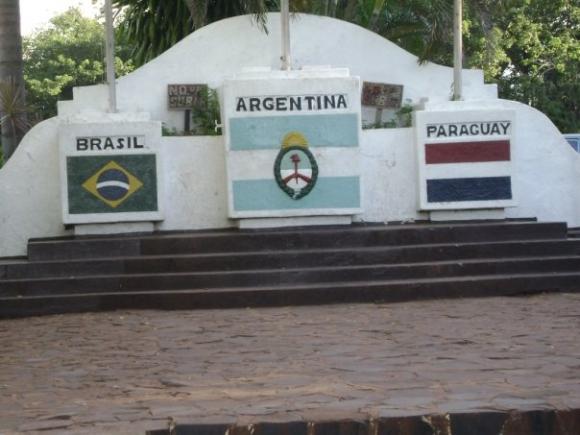La Tri-Border Area: triple frontera, is the border area between Brazil, Paraguay and Argentina. Its surface is about 2.500 square km and constitutes a region rich in natural resources. Indeed, it is here that the Guaranì aquifer system rises, an important source of fresh water (The war of the SAG by Maria Grazia Labellarte, 2015, nd.r). It is one of the largest underground reserves in the world, about 37.000 cubic km of water.
The three urban areas constitute the area are the Brazilian city of Foz do Iguaçu, the Paraguayan Ciudad del Este and the Argentine city of Puerto Iguazu, all three characterized by rapid urban and economic development in the last 40 years.
Ciudad del Este, founded in 1957, is the capital of Upper Paranà in Paraguay and the second largest city in the country; it is located 330 km east of the capital Asuncion.
Foz do Iguaçu extended for 191,46 square km in the State of Paranà, gravitates around Itaipù, the largest hydroelectric plant in the world built by Brazil and Paraguay in the sixties. The populous and multicultural city is among the main Brazilian tourist attractions.
Finally, Puerto Iguazú, the Argentine city of the province of Misiones, built at the confluence of the Iguazú and Paraná rivers. Founded in the 1901, although separated from the other two main urban centers of the region, it is part of the so-called Tri-Border Area grown exponentially thanks to the influx of Brazilians, Paraguayans, Argentines, Italians, Lebanese and Germans.
The different factors that have been the engine of growth in the region have pushed the demographic increase: the population of the whole area has passed from 60.000 to 700.000 inhabitants between the 1971 and the 2001. Only in Foz do Iguaçu for example, population growth was 401.3%.
The known security problems of the TBA they are related to the demographic trend and the lack of adaptation of the infrastructures necessary for orderly growth.
Social groups of different cultural, religious and ethnic orientation have created a "microclimate" in which local ties and a particular sense of belonging to the community have made a completely peculiar area grow that cannot be assimilated to any specific national territory.
The Brazilian city of Foz do Iguaçu for example, has a population of 260.000 inhabitants, coming from 80 different nationalities. More than a third of the population is under the age of 24 years. In addition to Portuguese and Spanish, Arabic and Chinese are the most widely spoken languages (an even more pronounced phenomenon in Ciudad del Este).
In Ciudad del Este the main ethnic communities are Chinese, Lebanese and Korean; it is believed that the Chinese constitute the second largest ethnic minority of the TBA, with more than 15.000 Chinese residents in the Paraguayan territory and more than 30.000 throughout the region, of which they represent the backbone of commercial activities, facilitated by tax breaks.
The bank China trust for example, it established one of its nine international branches, and the first in South America in Ciudad del Este.
The Arab communities also constitute one of the largest ethnic groups in the TBA. A considerable number of Arabs began to emigrate during the 1960s, especially in Foz do Iguaçu and Ciudad del Este, where schools, clubs and organizations linked to the Middle East have arisen over time. Arab immigrants living in the condos of Foz do Iguaçu represent the second largest Arab community in Brazil (after Sao Paulo).
It is estimated that around the 90% of Arabs in Foz do Iguaçu and Ciudad del Este are Lebanese, the rest are mainly of Palestinian, Egyptian and Jordanian descent.
The main import-export activities of the TBA, particularly in Ciudad del Este, they are the prerogative of the Arab community.
Most of the Arab population in TBA is of Muslim faith with a Shiite majority; to these are added the migratory Christian flows from Lebanon, Syria and North Africa, including many Egyptian Copts and Palestinian Christians, who emigrated over fifty years ago.
Among the characterizing features of the Tri-Bord-Area there is no doubt the reputation of being a "lawless" border area and an easy transit area for all types of goods, often real smuggling of everything that is considered illegal.
Its already mentioned urban centers are logistically important, where there are already connections between Arab Muslim communities and radical Islamic groups. Being a "free" area with flourishing illicit activities configures it as the ideal terrain for recycling and fundraising activities in support of fundamentalist terrorist groups. These premises would also fuel the already endemic corruption and a further demand for smuggled goods and illegal documents.
It is important to underline however that in recent years all the three neighboring countries of the TBA they have made enormous efforts to try to normalize the area at least from the point of view of legality. However, the contrast activity appears to be particularly difficult. Geographically the terrain facilitates drug trafficking, thanks to the impenetrable neighboring jungles that allow crime cartels to hide bases, training camps, plantations, laboratories and clandestine landing strips. An example is the Paraná river, used regularly for illicit traffic. The exponential and uncontrolled development of urban centers is another factor that makes the TBA a potential operational base for terrorists.
In densely urbanized and uncontrolled areas, where the markets of advanced technologies and low-cost instrumentation are swarming, in the general silence of world public opinion, the terrain is growing where to develop laboratories for export fundamentalism.
(Photo: Online Defense)












